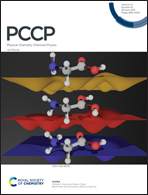Multiple dehydrogenation of fluorene cation and neutral fluorene using the statistical molecular fragmentation model
Abstract
The statistical molecular fragmentation (SMF) model was used to analyze the 306 fragmentation channels (containing 611 different species) that result from the fluorene (C13H10+) cation losing up to three hydrogen atoms (neutral radicals and/or a proton). Breakdown curves from such analysis permit one to extract experimentally inaccessible information about the fragmentation of the fluorene cation, such as the locations of the lost hydrogen atoms (or proton), yields of the neutral fragments, electronic states of the residues, and quantification of very low probability channels that would be difficult to detect. Charge localization during the fragmentation pathways was studied to provide a qualitative understanding of the fragmentation process. Breakdown curves for both the fluorene cation and neutral fluorene were compared. The SMF results match the rise and fall of the one hydrogen loss yield experimentally measured by imaging photoelectron-photoion coincidence spectroscopy using a VUV synchrotron.



 Please wait while we load your content...
Please wait while we load your content...